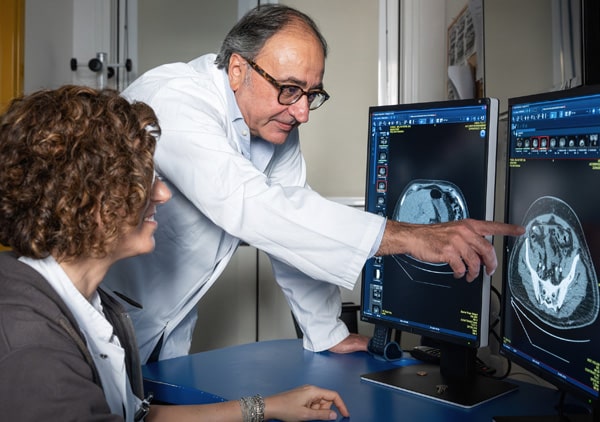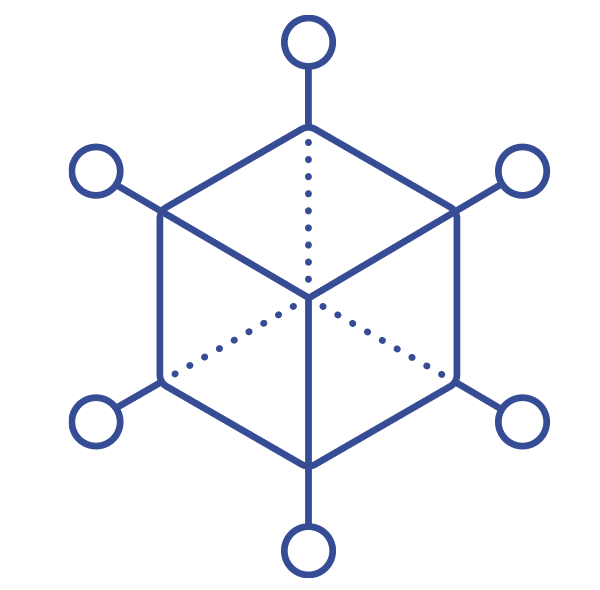AGFA HealthCare Enterprise Imaging Platform is supporting the ASL Roma 1 network in its goal to deliver unified patient care to over 36% of the city’s population, across 6 districts and following the merger of 3 healthcare enterprises.
In 2016, three healthcare institutions in Rome, Italy, merged to form Azienda Sanitaria Locale (ASL) Roma 1. This public health authority now operates five hospitals, across six districts, serving a population of more than 1.1 million people.
To enable it to meet the challenges, ASL Roma 1 defined two goals: creating a new, unified identity, and becoming a modern, reliable and innovative healthcare network.
AGFA HealthCare’s Enterprise Imaging Platform is helping ASL Roma 1 to achieve both of those goals.

Dr. Enrico Pofi
Head of the Imaging Department
CIO
“AGFA Health Care Enterprise Imaging offers comprehensive functionality, along with robustness and stability. It’s a truly multidisciplinary solution, and can be customized and adapted to the specific needs of different departments and users.”
Meeting geographical challenges
“We are dealing with the challenges of an extremely significant geographical distribution. The consolidated Enterprise Imaging solution has contributed to the unification of the three previous agencies – ASL Roma A, ASL Roma E and Azienda Ospedaliera San Filippo Neri – which each had their own organization and history. Having a single image management system helps us create a shared identity and culture, enabling us to improve delivery of care services to our patients,” begins Dr. Enrico Pofi, Head of the Imaging Department for ASL Roma 1.
Ing. Debora Angeletti, CIO of ASL Roma 1, agrees: “The image management system is a fundamental part of the hospital information architecture, playing a role not only in diagnosis and treatment, but also in prevention – an area of increasing importance and focus. That’s why we wanted a single solution that would support collaboration between our healthcare professionals, standardization of our diagnostic procedures, and the creation of an individual patient diagnostic history. Furthermore, with a single solution, we can better distribute the reporting process across sites and diagnostic specialties.”

“The image management system is a fundamental part of the hospital information architecture, playing a role not only in diagnosis and treatment, but also in prevention – an area of increasing importance and focus.”
AGFA HealthCare Enterprise Imaging delivers to ASL Roma 1:
- A single, enterprise-level data repository enabling sharing of images and reports across the network
- Comprehensive radiologist functionality with extensive customization options
- Integration of the image management platform with all digital diagnostic and information systems, according to current interoperability standards (DICOM, HL7, IHE)
- Distribution of images and reports digitally and online, including through the Lazio ESCAPE regional patient portal
- Access to prior radiology images for reference in the diagnostic process
- Access to images and reports even in the operating room
- Teleradiology support for urgent exams performed at the Regina Coeli Prison
- Integration with the SIPSO regional mammography screening system through the Elefante RIS
- Tools to monitor services performed and help eliminate repeated services, to enable optimization
of service delivery - Optimization of human, technological and financial resources

A smoother workflow with less distraction: ‘That’s life in flow’
The rich functionality of Enterprise Imaging delivers benefits not only on the organizational level, but to radiologists, clinicians, and patients as well. “Enterprise Imaging offers comprehensive functionality, along with robustness and stability. It’s a truly multidisciplinary solution that can be customized and adapted to the specific needs of different departments and users,” says Dr. Pofi. Among the distinctive features of Enterprise Imaging, he adds, are the straightforward interface, the ease of collaboration, and the ability to view exams carried out at any ASL Roma 1 facility.
“Radiologists particularly value the flexibility and customization of the hanging protocols, which improves their daily workflow. And they appreciate that the advanced post-processing tools they need are integrated in the Enterprise Imaging workstation, which reduces distractions. They no longer have to move from room to room, but can instead concentrate on their work, with all the tools within reach of a single click.”
All images, where they are needed
Clinicians and radiologists can access all of the images within the context of the patient’s medical record, thanks to the integrated XERO® Universal Viewer. “XERO is easy to use, is available on any compatible browser and device, and offers many functionalities. This has made it a ‘must-have’ tool,” explains Dr. Pofi.
The collaboration and sharing tools are another key advantage of Enterprise Imaging: “These stood out during the tender. We are already using them for our multidisciplinary oncology teams, as they allow very rapid and efficient interaction for the targeted analysis of an exam,” Dr. Pofi continues.
Enterprise Imaging also supports the network’s goal to create a single image data repository with not only radiology images, but also diagnostic images from other specialties, such as endoscopy, gastroenterology, gynecology, etc. This process is ongoing, and started with the endoscopy module.
“Radiologists particularly value the flexibility and customization of the hanging protocols, which improves their daily workflow. And they appreciate that the advanced post-processing tools they need are integrated in the Enterprise Imaging workstation, which reduces distractions.”
Seamless integration, enhancing the patient experience
The ability of Enterprise Imaging to integrate with the network’s existing systems, with regional platforms, and with third-party systems, is also supporting ASL Roma 1 to meets its patient experience and care quality objectives.
“Making images available to patients through a patient portal was at the heart of our goals when implementing Enterprise Imaging. The ability of Enterprise Imaging to integrate with the regional Lazio ESCAPE portal, where patients can download their radiological exam reports and images, was a significant advantage of AGFA HealthCare’s solution,” comments Dr. Pofi.
“I can also highlight Enterprise Imaging’s interoperability with our (3rd party) dose monitoring solution, our orthopedic planning system, and our dedicated obstetrics/gynecology image management system,” Ing. Angeletti adds.

Elefante RIS: dedicated functionality and connectivity capabilities
The AGFA HealthCare solution installed at ASL Roma 1 also includes the Elefante Radiology Information System (RIS), which has been developed to meet the specific needs and requirements of Italian healthcare providers.
“The Elefante RIS is one of the strengths of the entire AGFA HealthCare system, thanks to its extensive functionality as well as the availability and professionalism of the technical implementation service team, who helped us to customize many functions according to our needs and operational flows.
“Elefante RIS also offers connectivity capabilities that help meet our objectives. The double-blind mammography screening solution, for instance, is fully integrated with the SIPSO 2.0 regional oncology screening system, streamlining the screening procedures.”
A converged system offering performance and efficiency
The IT environment at ASL Roma 1 has to address the needs of a single, unified entity, while dealing with “the realities” of multiple hospitals explains Ing. Angeletti.
While the primary goals of the single Enterprise Imaging platform focus on enhancing patient care within a unified healthcare structure, the converged approach also offers efficiency gains, she explains: “For example, we can reduce costs by eliminating duplicate exams at different sites, and by avoiding the use of consumables, such as films and CDs, as we can now provide reports and images online.”
A starting point for the future
“Enterprise Imaging is not an arrival point but a starting point,” Ing. Angeletti describes. The hospital has many plans to evolve and extend the platform to meet both existing and future needs.
“The endoscopy module is the first example of extending the platform to non-radiological disciplines, but we would like to add other disciplines, such as anatomical pathology, to support our multidisciplinary approach. Next to that, we also intend to use the Enterprise Imaging Platform for enterprise-level telemedicine. And we are looking into the use of artificial intelligence algorithms to support diagnosis, reduce clinical risk, and enhance the efficiency of reporting.”
A hybrid architecture for a multi-site network
The Enterprise Imaging architecture for ASL Roma 1 comprises:

- A Hub-and-Spoke model for managing image and report archiving flows.
- A Point-to-Point model for sharing digital information between the different nodes.
- The combination of the two models makes it possible to create a single image management solution across a physically distributed system, independent of the wide area network.
Strategic partners for ASL Roma 1 goals
AGFA HealthCare and distributor Biesse Medica have and continue to play a key role. “Before we implemented Enterprise Imaging, AGFA HealthCare was already present in many of the ASL Roma 1 sites, providing service continuity and reliability during the migration. Furthermore, both AGFA and Biesse Medica have a significant presence in the region, which assured us that they had the resources needed during implementation, go-live and beyond. AGFA HealthCare and Biesse Medica have approached the relationship with ASL Roma 1 as true strategic partners, supporting us in all initiatives,” concludes Dr. Pofi.
AGFA HealthCare’s solution
- Enterprise Imaging for Radiology is a consolidated image management platform supporting productivity, collaboration and mobility.
- The Enterprise Imaging VNA delivers a single, enterprise-level data repository enabling sharing of images and reports across the network.
- The flexible Elefante RIS is fully integrated with the Enterprise Imaging Platform and can be customized to meet the specific needs of the hospital. The Double-Blind Reading Module for Mammo Screening is fully integrated with the SIPSO 2.0 regional oncology screening system.
- The XERO® Universal Viewer makes relevant multimedia content accessible anywhere, anytime, right from the EMR; and provides a rich collaboration toolset. XERO Xtend adds advanced clinical applications and 3D processing.
- The patient portal and integration with the Lazio ESCAPE regional platform, support the distribution of images and reports to patients.

Did you know ?
- ASL Roma 1 covers six districts of Rome and two prisons. It operates five hospitals (Ospedale San Filippo Neri, Ospedale Santo Spirito in Sassia, Ospedale Monospecialistico Oftalmico, Centro per la Salute della Donna S. Anna, and Presidio Cassia Sant’Andrea). In addition, the Presidio Nuovo Regina Margherita is integrated with the Ospedale Santo Spirito, for specific medical and surgical care pathways.
- The Ospedale Santo Spirito in Sassia is the oldest hospital in Europe. Its origins go back to 727, when it offered accommodation, assistance and care for pilgrims who came to Rome to visit St. Peter’s tomb. In 1198, Pope Innocenta III had the site rebuilt as a hospital.
- AGFA HealthCare was proud to contribute to the 2022 restoration of the “Monumental Complex of Santo Spirito in Sassia”. The project comprised the restoration of a pictorial cycle of frescoes in the Sistine Wards (‘Corsie Sistine’), as well as structural improvements to the ‘Grottone’ and the Lancisian Library, which represent the first Renaissance civil architecture in Rome.

